Three Days in Moldavia - JewishGen KehilaLinks
Three Days in Moldavia - JewishGen KehilaLinks
Three Days in Moldavia - JewishGen KehilaLinks
Create successful ePaper yourself
Turn your PDF publications into a flip-book with our unique Google optimized e-Paper software.
<strong>Three</strong> <strong>Days</strong> <strong>in</strong> <strong>Moldavia</strong> ©Jack H Bloom 1997<br />
<strong>Three</strong> <strong>Days</strong> <strong>in</strong> <strong>Moldavia</strong>;<br />
Treasures I didn't f<strong>in</strong>d <strong>in</strong> the archives. Jack H Bloom PhD<br />
I was one of sixteen <strong>in</strong>trepid explorers who follow<strong>in</strong>g the 5th International<br />
Sem<strong>in</strong>ar on Jewish Genealogy abandoned the amenities and pleasures of Paris<br />
for <strong>Moldavia</strong>, Romania. We went to search the archives for fragments of the<br />
paper trail that chronicled the lives of our ancestors who walked the roads and<br />
imbibed the vistas of this stunn<strong>in</strong>gly beautiful area.<br />
Organized and led by Rick Bercuvitz, after a couple days of sightsee<strong>in</strong>g we<br />
arrived at our base, the Hotel Traian <strong>in</strong> Iasi; (a no star hotel masquerad<strong>in</strong>g as a<br />
two star hotel). The next three days I had two wonderful experiences, neither<br />
hav<strong>in</strong>g anyth<strong>in</strong>g to do with archives.<br />
On day one, new friends Nat and Lucille Abramowitz accompanied me and our<br />
<strong>in</strong>terpreter Eugen Hriscu, a delightful, car<strong>in</strong>g 20-year-old medical student<br />
whose English was learned liv<strong>in</strong>g <strong>in</strong> a trailer park <strong>in</strong> the wilds of Texas as a<br />
Soros Foundation high school exchange student. I was thrilled to take the<br />
wheel of the group's Toyota m<strong>in</strong>ivan, and drive toward Hirlau and Frumusica,<br />
75 and 90 kilometers from Iasi, respectively. These towns had been home to<br />
my mother's family, Segall, and my father's extended family, the Blums. The<br />
Blum’s were quite well to do by the standards of the time. They even owned<br />
the build<strong>in</strong>g <strong>in</strong> which my maternal grandparents, the Segalls, lived. I have <strong>in</strong> my<br />
possession a copy of the build<strong>in</strong>g permit, granted to my relatives by the Hirlau<br />
authorities <strong>in</strong> 1907. They also built and ran the first movie theater <strong>in</strong> Hirlau,<br />
C<strong>in</strong>ema Lum<strong>in</strong>a. My grandfather Yekutiel Zalman Blum was the exception. He<br />
and his wife Miriam (my grandmother) had moved 15 kilometers up the road to<br />
Frumusica, to be closer to the peasants from whom he gathered milk and eggs<br />
and other produce, probably for resale <strong>in</strong> Hirlau.<br />
Hirlau<br />
This was not my first visit to Hirlau. I had been there <strong>in</strong> 1981, when I knew<br />
little about archives. At the time, my cous<strong>in</strong> Chaim Zeil<strong>in</strong>gher,z”l who lived <strong>in</strong><br />
Bucharest, gave me a letter of <strong>in</strong>troduction to one Gamliel Greenberg <strong>in</strong><br />
1
<strong>Three</strong> <strong>Days</strong> <strong>in</strong> <strong>Moldavia</strong> ©Jack H Bloom 1997<br />
Hirlau. Gamliel who remembered my mother, showed me her home, my<br />
maternal grandparents graves and some graves of my fathers uncles and<br />
aunts. Back <strong>in</strong> 1981 jo<strong>in</strong>ed by his friend, Yitzchak Abramovitz, Gamliel also<br />
showed me around the delightfully decorated Hirlau synagogue. where we were<br />
photographed together. For this trip, not know<strong>in</strong>g if Gamliel and Yitzchak<br />
were still alive I copied that photo and took it along, to show passerbys<br />
and ask if they knew the men <strong>in</strong> the photo and how I might contact them.<br />
Arriv<strong>in</strong>g <strong>in</strong> Hirlau, Eugen found the "synagoga" by ask<strong>in</strong>g everyone and anyone<br />
where it was. I remembered it well. It had not changed. The graceful old<br />
build<strong>in</strong>g opposite, which had stored the records of the Jewish Community, had<br />
been torn down by Ceaucescu and replaced with nondescript block hous<strong>in</strong>g.<br />
Eugen asked two kids stand<strong>in</strong>g nearby, how one might get <strong>in</strong>to the synagogue.<br />
They po<strong>in</strong>ted across the street offer<strong>in</strong>g that a man who lived there had the<br />
keys. The man came out, and I showed him the picture. He po<strong>in</strong>ted at the<br />
photo say<strong>in</strong>g; "Dos b<strong>in</strong> Ich" (That's me). This was Yitzchak Abramovitz, now 79<br />
and very much alive [see photo on next page]. I asked if Gamliel Greenberg,<br />
the other man <strong>in</strong> the orig<strong>in</strong>al photo, was still alive. He said "yes"; Gamliel,<br />
though widowed, was now 83 and <strong>in</strong> decent health. Yitzchak had seen him<br />
headed to the bank earlier that morn<strong>in</strong>g, but when we went to his house he<br />
was not there.. We set out to f<strong>in</strong>d him. We could not locate him now.<br />
Frumusica<br />
Not want<strong>in</strong>g to waste precious time, I suggested that we would go up the road<br />
to Frumusica, which my father had described as hav<strong>in</strong>g the horse at one end of<br />
town and the wagon at the other. I hoped to f<strong>in</strong>d my father's birth certificate<br />
(Dec. 29, 1894) and establish if there was a Jewish cemetery where I might<br />
f<strong>in</strong>d my grandfather's tombstone (I had been thrown out of Frumusica <strong>in</strong><br />
1981, but that is another story.) My father’s birth certificate wasn't there.<br />
though the officials of the little town certa<strong>in</strong>ly did search. The 100-year rule<br />
had moved all old records out of local towns to the county seat, Botosani.<br />
There was a fenced-<strong>in</strong> Jewish cemetery, but <strong>in</strong> such dishevelment and disrepair<br />
that there was no way to f<strong>in</strong>d a specific grave, even if my grandfather had<br />
been buried there. I took a couple of photos, recited an El Maleh; said kaddish<br />
2
<strong>Three</strong> <strong>Days</strong> <strong>in</strong> <strong>Moldavia</strong> ©Jack H Bloom 1997<br />
for all those for whom this was their eternal rest<strong>in</strong>g place, I then headed back<br />
to Hirlau.<br />
Back <strong>in</strong> front of the synagogue, Yitzchak and his granddaughter greeted us,<br />
piled <strong>in</strong>to the van and off we went to Gamliel's home. After the proper<br />
greet<strong>in</strong>gs, Gamliel who may have been wear<strong>in</strong>g the same suit and hat as <strong>in</strong><br />
1981, asked if we wanted to visit the Hirlau cemetery, of which he was now <strong>in</strong><br />
charge. I had seen the cemetery <strong>in</strong> 1981 when it was <strong>in</strong> good repair. That was<br />
thanks to the efforts among others of Bernard Schwartz z'l, , a native of Hirlau,<br />
a good friend of my parents, and active along with them <strong>in</strong> the United Harlauer<br />
Society, a landsmanschaft <strong>in</strong> New York,. I wanted to see it aga<strong>in</strong>.<br />
Gamliel went <strong>in</strong>to his house to retrieve the cemetery plan. It was an old, very<br />
old, dog eared notebook, f<strong>in</strong>ger marked all over, which he simply rolled up and<br />
stuffed <strong>in</strong> the side pocket of his suit, which was half as old as he was. As we<br />
headed off to the cemetery, Nat tapped me on the shoulder, whisper<strong>in</strong>g <strong>in</strong> my<br />
ear;<br />
"You have to get hold of that notebook-it's <strong>in</strong>valuable... when he dies,<br />
there will be no record... that cemetery plan will be lost. It is a vital<br />
document. Get it. Get it. Get it."<br />
Nat kept at it , nudg<strong>in</strong>g and rem<strong>in</strong>d<strong>in</strong>g me repeatedly as we made our way<br />
through the cemetery. We asked Gamliel if we could copy the notebook, not<br />
know<strong>in</strong>g if there was a copy mach<strong>in</strong>e <strong>in</strong> town-(If you had used the toilets <strong>in</strong><br />
Romania, you would wonder too!) Gamliel had no objection. We found a store<br />
which had no phone, but where miracle of miracles, there was a Xerox mach<strong>in</strong>e,<br />
which at 400 Lei per page, could do the whole th<strong>in</strong>g. S<strong>in</strong>ce it was go<strong>in</strong>g to<br />
take a while, I took everyone to lunch at the Hotel, across the street, (You<br />
shouldn't know of such hotels!) which as it turned out stood on the site of the<br />
C<strong>in</strong>ema Lum<strong>in</strong>a , built by my aunt and her husband.<br />
I returned to Iasi that first day without any death or birth records but with the<br />
cemetery plan of Hirlau, a document from the past, for the future. The first<br />
day was a triumph! Noth<strong>in</strong>g more needed to happen for me <strong>in</strong> <strong>Moldavia</strong>. The<br />
cemetery plan of Hirlau alone made the whole trip worthwhile. And so we<br />
returned to Iasi, to our lodg<strong>in</strong>gs <strong>in</strong> the Hotel Traian.<br />
3
<strong>Three</strong> <strong>Days</strong> <strong>in</strong> <strong>Moldavia</strong> ©Jack H Bloom 1997<br />
N.B.(Translated by Rony Shaham who lives <strong>in</strong> Israel and with some pages later<br />
on recopied with the help of Eugen Hriscu, it now is <strong>in</strong> the archives of the<br />
Romanian Special Interest Group of The Jewish Genealogical Society. Nat<br />
Abramowitz, who passed to his own reward a couple of years back was<br />
absolutely correct.)<br />
Frumusica aga<strong>in</strong><br />
Now the question was; What to do on day two? The Toyota m<strong>in</strong>ibus was be<strong>in</strong>g<br />
sent with a driver (not me) to Botosani. a two-hour trip, routed through Hirlau<br />
and past Frumusica. Hav<strong>in</strong>g had no luck the first day with archival records <strong>in</strong><br />
Frumusica, I could choose to go to Hirlau or return to Frumusica to search<br />
further, perhaps for my grandfather’s death certificate, or my father's house. I<br />
now also knew that though Frumusica and Hirlau were less than 10 miles from<br />
each other, Frumusica's older-than-100-years records were <strong>in</strong> Botosani and<br />
Hirlau's records <strong>in</strong> Iasi. There were some vague <strong>in</strong>dications <strong>in</strong> my family chart of<br />
Botosani orig<strong>in</strong>s on both sides of the family, so on a hunch, and without much<br />
hope, th<strong>in</strong>k<strong>in</strong>g that I could get off <strong>in</strong> Hirlau or Frumusica if the spirit moved me,<br />
I jo<strong>in</strong>ed the Botosani expedition.<br />
At my request, the bus stopped <strong>in</strong> Frumusica for fifteen m<strong>in</strong>utes. I went <strong>in</strong>to<br />
the town hall search<strong>in</strong>g for my grandfather's death certificate (ca. 1906-7),<br />
and home ownership records from the beg<strong>in</strong>n<strong>in</strong>g of the century, which if they<br />
existed might let me see the house my father grew up <strong>in</strong>.. Noth<strong>in</strong>g useful<br />
resulted except to hear how impoverished the little town was and how they<br />
needed medical supplies, which if they got, they might then be able to<br />
refurbish the cemetery. So, empty handed, back on the bus to Botosani.<br />
Botosani: A Surprise Encounter<br />
On the bus, Bruno Segal,(no relation to my mother whose maiden name was<br />
Segall-the name is as common as Smith <strong>in</strong> the US) born <strong>in</strong> Romania and<br />
search<strong>in</strong>g for his grandparents' graves <strong>in</strong> Botosani, suggested go<strong>in</strong>g first to the<br />
Jewish Community offices, where there might be a Botosani cemetery plan,<br />
rather than to the Romanian regional state archives. We arrived <strong>in</strong> Botosani, a<br />
4
<strong>Three</strong> <strong>Days</strong> <strong>in</strong> <strong>Moldavia</strong> ©Jack H Bloom 1997<br />
term<strong>in</strong>ally gray city, and wandered around for an hour before we located the<br />
rather tacky yet dignified offices of the Jewish community.<br />
Botosani once had over 20,000 Jews, and twenty-one synagogues now<br />
reduced to two. No doubt so that the 104 rema<strong>in</strong><strong>in</strong>g Jews could say of one or<br />
the other. "That one I would never pray <strong>in</strong>."<br />
Upon enter<strong>in</strong>g the offices, we were met by the Community head, (Rosh<br />
HaKehillah) whose picture appeared <strong>in</strong> a collage on the wall, officiat<strong>in</strong>g at Bar<br />
Mitzvahs, wedd<strong>in</strong>gs, brises and other community activities. After two hours <strong>in</strong><br />
the bounc<strong>in</strong>g bus, I needed to use the" toilett<strong>in</strong>". So my <strong>in</strong>itial attention was<br />
elsewhere. By the time I returned this man was gather<strong>in</strong>g <strong>in</strong>formation as to the<br />
death dates of Bruno's grandparents, and their location <strong>in</strong> the Botosani<br />
cemetery. Though I had seen his visage on the walls, I had not heard his name<br />
and s<strong>in</strong>ce we were about to leave, wished to at least say shalom to this man. I<br />
asked Naomi Lowi What’s this man’s name? She responded; Tirer.<br />
TIRER! -I shouted!? Eyes grow<strong>in</strong>g wide I ran back <strong>in</strong>, and stood face to face<br />
with him.<br />
Your name is Tirer?<br />
Yes!<br />
Do you know Chaim Tirer? (My father’s sister’s son)<br />
Yes, of course; He's my cous<strong>in</strong>.<br />
Well, He's my first cous<strong>in</strong>!<br />
I then asked him about the family. He rattled off virtually all the names <strong>in</strong> both<br />
my father's and mother's family. There we were, hold<strong>in</strong>g both hands, kiss<strong>in</strong>g<br />
both cheeks, hugg<strong>in</strong>g each other, tears well<strong>in</strong>g up, chills down the sp<strong>in</strong>e,<br />
exchang<strong>in</strong>g addresses, tak<strong>in</strong>g pictures, gasp<strong>in</strong>g <strong>in</strong> disbelief. David, Naomi and<br />
Bruno later said it was, for them, one of the special moments of the trip.<br />
I came to Romania seek<strong>in</strong>g archival records of dead relatives and <strong>in</strong>stead found<br />
a live one- Joseph Tirer, Rosh HaKehillah of Botosani no less. A cous<strong>in</strong> I didn't<br />
know existed. He wasn't even on my chart. It was one of life's peak moments.<br />
The next day I was thrown out of the archives <strong>in</strong> Hirlau. But that's a different<br />
story.<br />
5
<strong>Three</strong> <strong>Days</strong> <strong>in</strong> <strong>Moldavia</strong> ©Jack H Bloom 1997<br />
6



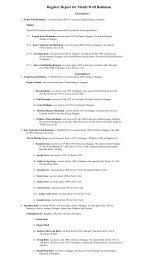
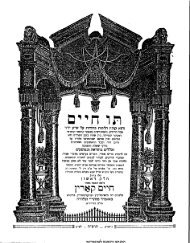
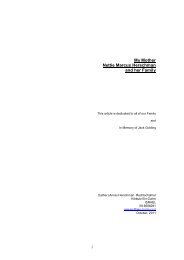
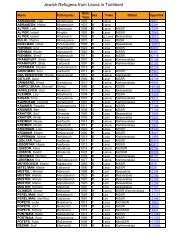
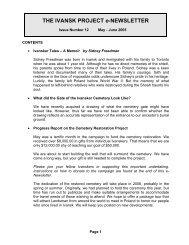
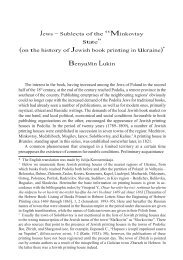
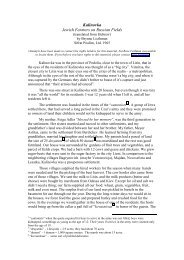
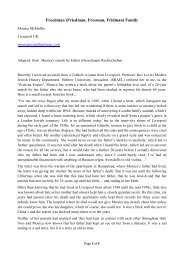
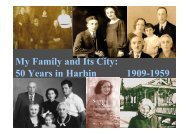


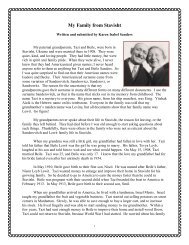

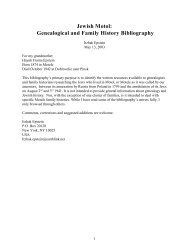
![Carta de Jaime Cesar [Negro] Lipovetzky - JewishGen KehilaLinks](https://img.yumpu.com/19183893/1/190x245/carta-de-jaime-cesar-negro-lipovetzky-jewishgen-kehilalinks.jpg?quality=85)